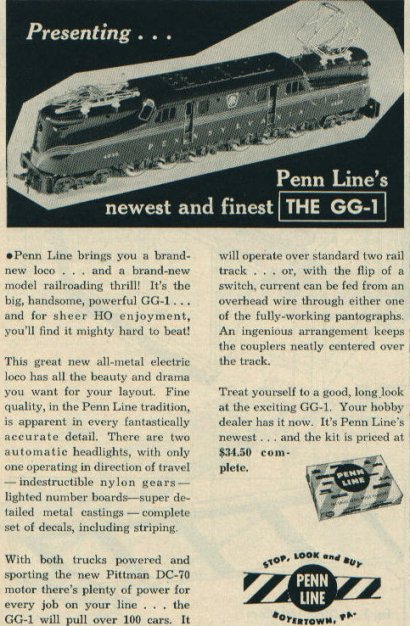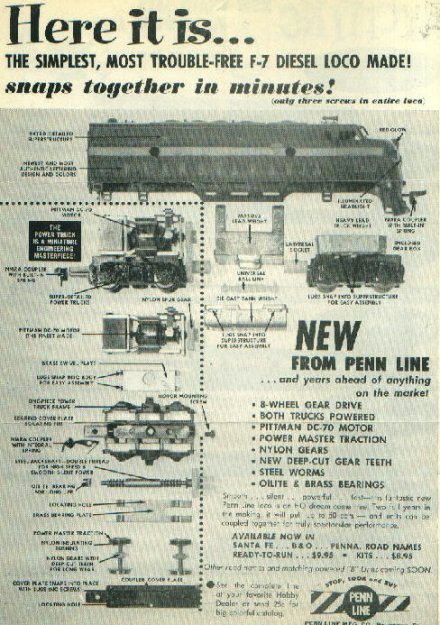 |
 |
|---|
A Short History of Penn Line |
By Frank Dill |
The Middle Years |
Ready to Run - Train Sets |
| During the 1950's the biggest product change was the addition of
sets. These sets usually consisted of a prebuilt loco, a half dozen
or less cars, and enough snap track to make a simple loop. Penn Line
sold both passenger and freight sets. Let's take a look at the mid decade
1955 selection. Penn Line's 1955 catalog shows seven sets ranging in
price from $24.95 to $64.95. The cheapest set included the Midget
switcher loco, the rest came with Penn Line's Diesel "A" unit. That
year Penn Line only offered the Northern Pacific color scheme. The reason
for this was that the passenger cars were German made Fleischmann cars.
Only a paper sticker on the underside of the cars identified them
with Penn Line. These had lithographed steel sides and are easily distinguished
from the later plastic body passenger cars. Fleischmann had Pennsylvania
Railroad passenger cars in 1955. I have no idea why Penn Line
chose to market Northern Pacific. The company was named because of their
desire to make Pennsylvania Railroad products. It is the same type of
reasoning that caused them to start by marketing the Reading Railroad
Crusader. In the 1950's the baby boomers were just coming to the right age to receive a train set for Christmas. There was clearly a larger potential market here than there was at that time for the higher quality steam locomotive kits. The problem was that Penn Line competitors saw the same potential. The December 1955 issue of Model Trains contained a train set Buyers' Guide. The guide showed 50 HO scale sets by companies such as Fleischmann, Rivarossi, Tyco, HObbyline, Varney, Gilbert, Custombilt, Athearn, Herkimer, Kusan-Auburn, and of course Penn Line. At first the market for HO sets may have been expanding, but the number of companies was also expanding. When you look at the sets offered in 1955, Penn Line's offerings did look particularly distinguished from the rest. In particular that year they offered no set that included their high quality steam locomotives. Their diesel locomotive was largely undistinguished from other company offerings. That year they did offer one nice feature a real diesel horn in the locomotive that could be sounded anywhere on the track with a control button. During this period the company also offered an interesting product Speedi-Trak. This was a deluxe track that with a rubber roadbed. The sets, however, came only with standard Atlas track. The last half of the 1950 decade was a period when Penn Line attempted to distinguish their sets form those of the crowd. The first major step was to start offering the sets with the top quality steam locomotives. By 1958 Penn line was offering sets which included one of three different steam locomotives, the GG-1 electric, the F-7 Diesel, or the Midget Diesel Switcher. They were only offering nine different sets but there were seven different locos between the nine sets. Thus they got the appearance of variety without having to offer a much greater number of products. Penn Line put a lot of effort into the GG-1 and the F-7 as these ads show. Every Penn Line collection should have a GG-1. The F-7 was a low end product. The plastic steps easily broke off. As the F-7 ad says "years ahead of anything on the market." Actually within a year other companies had copied many of its features. Penn Line also developed a GP-9 using similar features to the F-7. For the serious collector get the GG-1, you can skip the F-7 and GP-9. |
 |
 |
|---|
| The extra touches on the GG-1 were in keeping with
Penn Line's hobbyist attitude, features like the two automatic headlights,
with only one operating in direction of travel and the fully working
pantographs. Every extra feature raised the development and production
costs. The next year things got really complicated. Since the passenger cars were now plastic bodied like the F-7 locos it was a seemingly easy matter to change the rail name by just snapping on a differently painted plastic body. It was a seemly easy matter to produce each set in different road names. In 1959 there were basically just 14 different kinds of sets, but some of them were offered in as many as five different road names. This "seeming" easy expansion meant there were 37 different combinations shown in the 1959 catalog. The idea was that buyers would want a set with their region's railroad name. All told a buyer could get at least one set in the following road names- Santa Fe, Denver & Rio Grande, New Haven, Milwaukee, Southern Pacific, Baltimore & Ohio, Union Pacific, Wabash, Great Northern, Burlington, and of course Pennsylvania. Oh, did I mention that some of the lines were made in both Streamlined and Standard passenger cars. So what was the problem here? If you have been paying attention you know what the problem was. Link here for a hint. Look at the address on the order form. There was a big expansion going on but the company was still at 35 S. Franklin Street. Just look back above at the factory building. There was no way that all this could be done in such a small building. But a larger building did not solve the problem. I will explain more in the next section. In the mean time lets look at how the expansion was financed. |